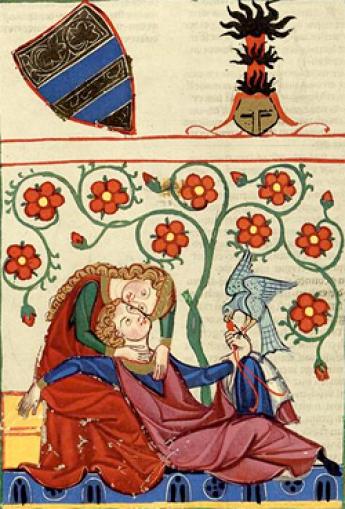The Codex Manesse and the Discovery of Love Heidelberg shows one of the most beautiful medieval manuscripts

On the occasion of the 625th anniversary of the University Heidelberg (Germany) the Heidelberg University Library presents its most precious treasure and one of the most important literary resource of German literary history: the Codex Manesse.
The exquisitely illuminated medieval manuscript was written at the beginning of the 14th century in Zurich presumably due to the initiative of Johann and Rüdiger Manesse. The manuscript unites the entire range of Middle High German poetry, the oldest texts date back as far as the mid 12th century. Many poems are uniquely documented here: The Codex Manesse is one of the key testimonies for the literature and culture of the Staufer dynasty.
The texts are preceded by a total of 138 miniatures with idealistic portraits of the poets. The first illustrations depict the most noble of all poets, the Staufer rulers Emperor Henry VI and King Konradin. Dukes and gentlemen are followed by professional poets such as Walther von der Vogelweide or Wolfram von Eschenbach. The predominate theme is the “Minne”, the intimate courtly love between men and women. Whilst courtly love was of no importance in the written records of the Early Middle Ages, love was discovered as a literary topic in the Staufer era. The discourse on courtly love not only influenced the relationship between the sexes but also altered the gentry’s self-image and the forms of etiquette within courtly society. Hence, it was no longer sufficient for a knight to only possess the lady he adored – he had to be loved by her. The poems and illustrations of the Codex Manesse capture these changes in a beautiful artistic manner.
The Codex Manesse and the Discovery of Love
26th October 2010 - 20th February 2011, at Heidelberg University Library, opened daily 10 am to 6 pm
Exhibition Catalogue (in German)
“Der Codex Manesse und die Entdeckung der Liebe”. Edited by Maria Effinger, Carla Meyer and Christian Schneider. Heidelberg: Universitätsverlag Winter, 2010
The exhibition is displayed within the context of the large medieval exhibition “The House of Hohenstaufen and Italy” in the Reiss-Engelhorn-Museums Mannheim from 19th September 2010 until 20th February 2011.
>>> The Codex Manesse and the Discovery of Love
>>> The House of Hohenstaufen and Italy
